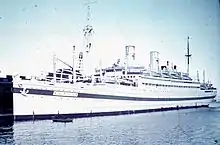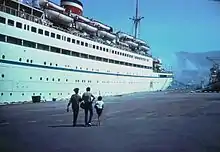SS Admiral Nakhimov
SS Admiral Nakhimov (Russian: Адмирал Нахимов), launched in March 1925 and originally named SS Berlin, was a passenger liner of the German Weimar Republic later converted to a hospital ship, then a Soviet passenger ship. On 31 August 1986, Admiral Nakhimov collided with the large bulk carrier Pyotr Vasev in the Tsemes Bay, near the port of Novorossiysk, Russian SFSR, and quickly sank. In total, 423 of the 1,234 people on board died.
.jpg.webp) SS Admiral Nakhimov sailing under her original name, Berlin, in 1925. | |
| History | |
|---|---|
| Name: | SS Berlin |
| Namesake: | City of Berlin, Germany |
| Owner: | Norddeutscher Lloyd |
| Builder: | Bremer Vulkan |
| Launched: | 24 March 1925 |
| Reclassified: |
|
| Homeport: | Bremen, Weimar Republic |
| Identification: |
|
| Fate: | Sunk by a mine near Swinemünde, salvaged by the Soviet Union in 1949. |
| Name: | SS Admiral Nakhimov |
| Namesake: | Admiral Pavel Nakhimov |
| Owner: | Black Sea Steamship Company |
| Port of registry: |
1949–1986: Odessa, |
| Out of service: | 1986 |
| Reclassified: | passenger liner (1957–1986) |
| Identification: |
|
| Fate: | 31 August 1986: sunk in a collision with bulk carrier Pyotr Vasev |
| General characteristics | |
| Type: | Passenger liner |
| Tonnage: | |
| Length: | 572 ft (174 m) |
| Beam: | 21.02 m (69.0 ft) |
| Speed: | 16 knots (30 km/h; 18 mph) |
| Capacity: | 1,101 + 24 extra passengers: 323 first-class; 290-second-class; 488 third-class; |
| Crew: | 313 + 41 extra crew |
History
Career: 1925–1945
Berlin was built by Bremer Vulkan at Vegesack, Germany (Yard 614) and was completed in March 1925. She was launched on 25 March 1925, and commissioned on 17 September 1925. The ship was 572 feet (174 m) long, had four decks and a volume of 15,286 GRT. She originally operated the Bremen – Southampton – Cherbourg – New York City run for the North German Lloyd Line.
The ship's main route was between Bremerhaven, Southampton and New York, which she began on 26 September 1925 and operated until May 1939 when she was laid up in Bremerhaven for refitting. On 12 November 1928, Berlin rescued the passengers and crew of the liner Vestris,[1] which sank off the coast of Virginia en route from New York City to Barbados. An estimated 113 people died in the sinking.
Berlin was chartered by the Nazis in 1939 as a Strength Through Joy (Kraft durch Freude, KdF) workers' cruising ship and was used as a hospital ship later on in World War II.
World War II

Berlin was one of eight German ships commissioned as hospital ships (Lazarettschiffe) during World War II. Most, if not all, of these ships also served in other capacities during the war after being decommissioned as hospital ships, mainly as accommodation or transport ships for military personnel. All German hospital ships were given alphabetic identifiers, Berlin's being 'A'. On 16 July 1939, Berlin began her conversion to hospital ship and entered service with the Kriegsmarine as Lazarettschiff A, Sanitätsamt Ost on 23 August 1939. The ship had berthing for 400 patients, with a crew of 165. Initially serving in Norwegian waters, she was identified as "Field Post Number 07520". By January 1945, Berlin was assigned to Operation Hannibal, the transport of refugees and soldiers from the Eastern Baltic. On 31 January 1945, while forming up in convoy to head east, Berlin struck a mine off Swinemünde, and was put in tow for Kiel.[2] She then hit another mine and was beached (23.53 hr, at position 54°02.6 N/14°19 E, in shallow waters). There was one fatality. All usable equipment was salvaged by 5 February 1945, and the ship was abandoned.
Soviet service
She was refloated and salvaged by the Soviets in 1949 and renamed Admiral Nakhimov after Admiral Pavel Nakhimov, a 19th-century Russian naval commander who played a prominent role in the Crimean War. After her conversion, her size was increased to 17,053 GRT. She entered passenger service for the Black Sea Steamship Company in 1957. In 1962, during the Cuban Missile Crisis, the ship was used to transport soldiers to Cuba.
During the peak summer travel season, Admiral Nakhimov operated cruises on the Black Sea between Odessa and Batumi, a six-day round trip. She carried an average of 1,000 people per voyage. She was the flagship of the Black Sea passenger fleet for several years until more modern liners entered service.
Sinking

At 10:00 p.m. Moscow Time on 31 August 1986, Admiral Nakhimov sailed from Novorossiysk en route to Sochi, its next stop. There were 888 passengers and 346 crew members aboard. Most of the passengers were Ukrainian, with others from Russia, Moldova, the Baltic republics and Central Asia. The captain of the ship was Vadim Markov.
Just minutes into the voyage, the ship's pilot noticed that the large bulk carrier Pyotr Vasev was on a collision course with Admiral Nakhimov. Pyotr Vasev was a Japanese-built, 18,604-ton freighter recently acquired by the Soviet Union, and was carrying a cargo of oats and barley from Canada. The pilot radioed a warning to Pyotr Vasev, and the freighter responded, "Don't worry. We will pass clear of each other. We will take care of everything."
Despite the message, Captain Viktor Tkachenko of Pyotr Vasev did nothing to slow his ship or change course. Convinced that the freighter would pass without incident, Captain Markov of Admiral Nakhimov retired to his cabin, leaving his second mate Alexander Chudnovsky in charge. From 11:00 p.m., Chudnovsky radioed Pyotr Vasev several times, asking about her course and her further actions. Chudnovsky changed the ship's course 10 degrees portside. At 11:10 p.m., Chundovsky cried on VHF to the freighter, "Immediately reverse full astern!" When it was clear that the freighter was headed directly for the ship, Pyotr Vasyov's engines were thrown in reverse. Admiral Nakhimov turned hard to port, but it was too late.
At 11:12 p.m., Admiral Nakhimov was struck by Pyotr Vasev 8 nautical miles (15 km; 9.2 mi) from the port at Novorossiysk and 2 nautical miles (3.7 km; 2.3 mi) from shore, at 44°36′15″N 37°52′35″E While many passengers had gone to bed by this time, some were on deck listening and dancing to music. They could only watch helplessly as the freighter rammed into the starboard side of the ship at a speed of about 5 knots (9.3 km/h; 5.8 mph). Admiral Nakhimov continued forward with the freighter's bow in its side, ripping a 900-square-foot (84 m2) hole in the hull between the engine and boiler rooms.
Admiral Nakhimov immediately took on a list on her starboard side, and her lights went out upon impact. After a few seconds, the emergency diesel generator powered on, but the lights went out again two minutes later, plunging the sinking ship into darkness. People below decks found themselves lost in the dark and rapidly canting hallways.
There was no time to launch the lifeboats. Hundreds of people dived into the oily water, clinging to lifejackets, barrels and pieces of debris.
Admiral Nakhimov sank in only seven minutes. Rescue ships began arriving just 10 minutes after the ship went down. Pyotr Vasev was not badly damaged, and assisted in the rescue effort. Sixty-four rescue ships and 20 helicopters rushed to the scene, and 836 people were pulled from the water. Some people were so slick with fuel oil that they could not keep hold of the hands of their rescuers. Sailors had to jump into the water to save people.
Admiral Nakhimov lacked proper ventilation, which was the reason all 90 windows in the cabins were open during the accident. The bulkheads that would have prevented the ship from sinking were removed during the conversion.
Passengers and crew had little time to escape, and 423 of the 1,234 on board perished. Sixty-four of those killed were crew members and 359 were passengers.
The event was not reported in the news for forty eight hours. The survivors were only allowed to send telegrams saying "Alive and well in Novorossiysk."
The wreck of Admiral Nakhimov lies on its starboard side in 150 feet (46 m) of water in Tsemes Bay off Novorossiysk.
Pyotr Vasev was renamed and operated under other flags until 2012.
Investigation
The Soviet government formed a commission of inquiry to investigate the disaster. It determined that both Captain Markov of Admiral Nakhimov and Captain Tkachenko of Pyotr Vasev had violated navigational safety rules. Despite repeated orders to let Admiral Nakhimov pass, Tkachenko refused to slow his ship and only reported the accident 40 minutes after it occurred. Captain Markov was absent from the bridge. The inquiry took place in 1987 in Odessa. Both Captains Markov and Tkachenko were found guilty of criminal negligence and sentenced to 15 years in prison. Both were released in 1992.
See also
References
- Newspaper account of Vestris disaster.
- Koburger, Charles, Steel Ships, Iron Crosses, and Refugees, Praeger Publishing, NY, 1989, p.84.
Bibliography
External links
- (in Russian) A website dedicated to the catastrophe